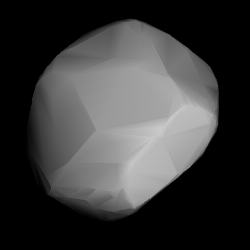 3D model based on lightcurve data | |
| Discovery | |
|---|---|
| Discovered by | Viktor Knorre |
| Discovery date | 1 July 1884 |
| Designations | |
| (238) Hypatia | |
| Pronunciation | /hɪˈpeɪʃiə/[1] |
Named after | Hypatia |
| A884 NA, 1947 HA | |
| Main belt | |
| Adjectives | Hypatian |
| Orbital characteristics[2] | |
| Epoch 31 July 2016 (JD 2457600.5) | |
| Uncertainty parameter 0 | |
| Observation arc | 124.07 yr (45318 d) |
| Aphelion | 3.1652 AU (473.51 Gm) |
| Perihelion | 2.6514 AU (396.64 Gm) |
| 2.9083 AU (435.08 Gm) | |
| Eccentricity | 0.088335 |
| 4.96 yr (1811.5 d) | |
Average orbital speed | 17.47 km/s |
| 170.00° | |
| 0° 11m 55.392s / day | |
| Inclination | 12.413° |
| 183.89° | |
| 210.750° | |
| Physical characteristics | |
| Dimensions | 148.49±3.6 km[2] 146.13 ± 2.66 km[3] |
| Mass | (4.90 ± 1.70) × 1018 kg[3] |
Mean density | 2.99 ± 1.05 g/cm3[3] |
| 8.8749 h (0.36979 d) | |
| 0.0428±0.002 | |
| C | |
| 8.18 | |
238 Hypatia is a large main-belt asteroid that was discovered by Russian astronomer Viktor Knorre on July 1, 1884, in Berlin. It was the third of his four asteroid discoveries. The name was given in honour of philosopher Hypatia of Alexandria. Based upon the spectrum, it is classified as a C-type asteroid[4] and is probably composed of primitive carbonaceous material. Like many asteroids of this type, its surface is very dark in colour.

Photometric observations of this asteroid at the European Southern Observatory in 1981 gave a light curve with a period of 8.9 ± 0.1 hours and a brightness variation of 0.12 in magnitude.[5] Stellar occultation events were observed for this asteroid during 2001 and 2005. The resulting chords provided cross-section diameter estimates of 146.5 and 145.3 km, respectively.[6]
- ^ "Hypatia". Lexico UK English Dictionary. Oxford University Press. Archived from the original on March 23, 2020.
- ^ a b Cite error: The named reference
JPLwas invoked but never defined (see the help page). - ^ a b c Cite error: The named reference
Carry2012was invoked but never defined (see the help page). - ^ Cite error: The named reference
aas128_525was invoked but never defined (see the help page). - ^ Cite error: The named reference
Schober1983was invoked but never defined (see the help page). - ^ Cite error: The named reference
Shevchenko_Tedesco_2006was invoked but never defined (see the help page).